Tannins are one of the most natural, non-toxic, and highly reactive aromatic biomolecules classified as polyphenols. The reactive phenolic compounds present in their chemical structure can be an alternative precursor for the preparation of several polymeric materials for applications in distinct industries: adhesives and coatings, leather tanning, wood protection, wine manufacture, animal feed industries, and recently also in the production of new porous materials (i.e., foams and gels). Among these new polymeric materials synthesized with tannins, organic and carbon gels have shown remarkable textural and physicochemical properties.
- tannin
- polyphenolic molecules
- sol-gel
- organic gel
- carbon gel
- hydrothermal carbonization
- porous materials
- pore structure
- biopolymer
- low-cost
1. The Chemistry of Tannins
1.1. Definition and Classification
1.2. Condensed Tannins
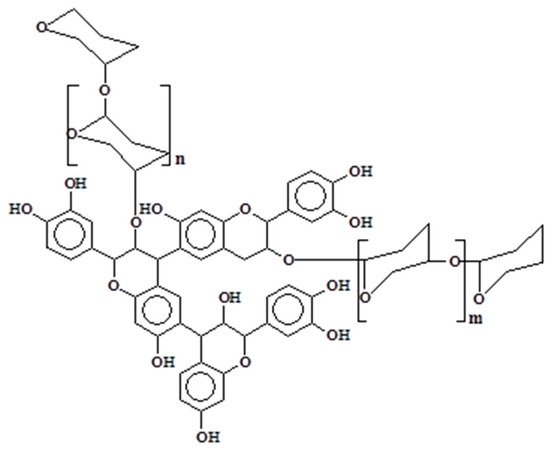
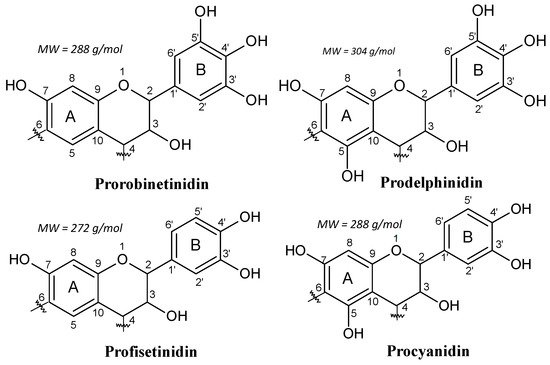
2. Tannin Gels
2.1. Tannin Gels Synthesis
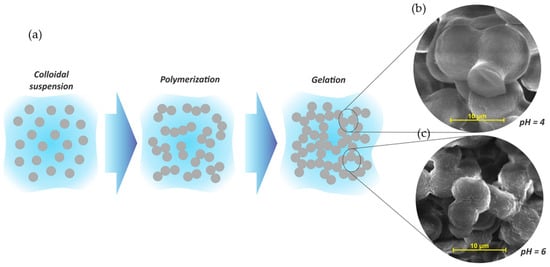
2.2. Mechanisms
2.2.1. Tannin-Formaldehyde-Systems
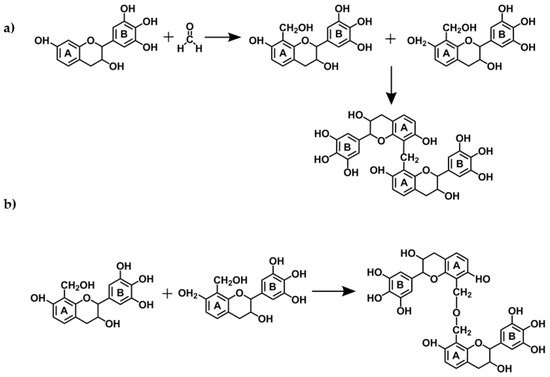
2.2.2. Influence of pH and Mass Fraction

2.2.3. Tannin-Soy-Formaldehyde Gels
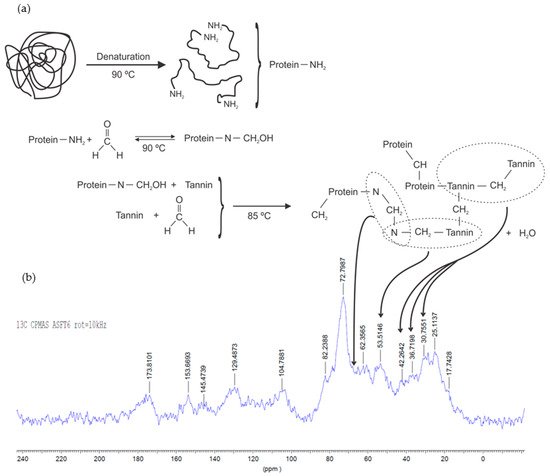
2.3. Preparation Methods and Conditions
2.3.1. Hydrogels Formulations at Normal Conditions
2.3.2. Solvent Exchange
2.3.3. Drying Conditions and Final Physicochemical Properties of Tannin Gels
-
Subcritical drying: Gels are dried under atmospheric conditions to form xerogels.
-
Freeze-drying: Gels are dried at freezing conditions to produce cryogels.
-
Supercritical drying: Gels are dried at a critical point of a working fluid to produce aerogels.
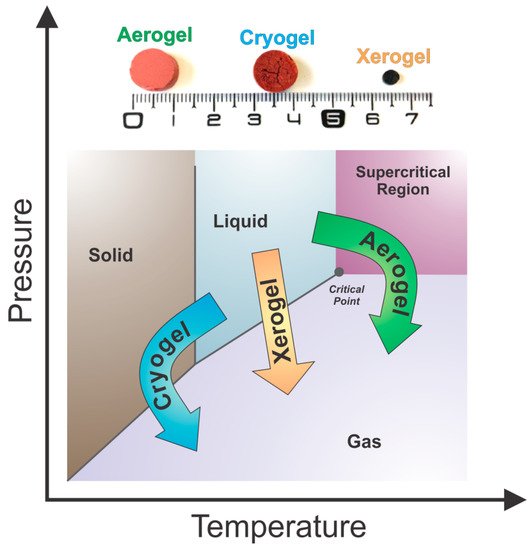
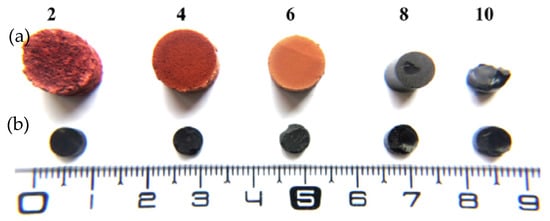
2.4. Hydrogels Formulations under Hydrothermal Conditions
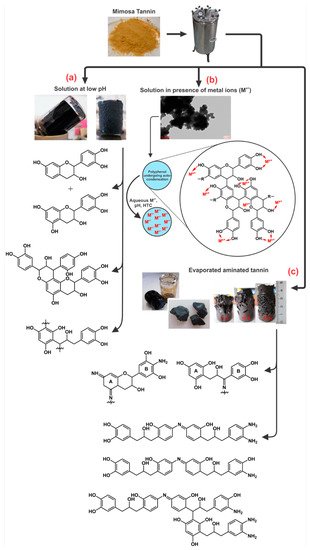
2.5. Thermal Treatment of Organic Gels
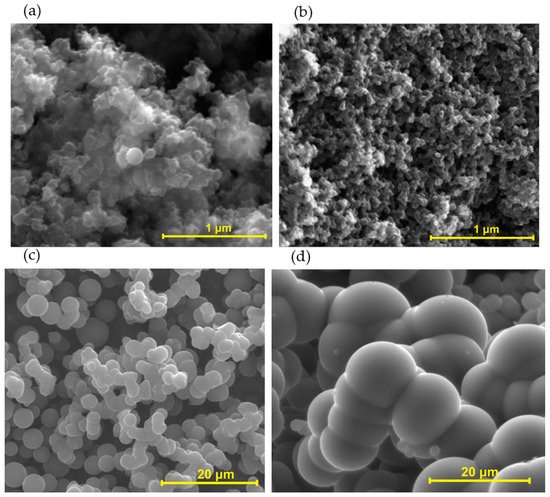
2.6. Applications of Organic and Carbon Tannin Gels
This entry is adapted from the peer-reviewed paper 10.3390/biom9100587
References
- Arbenz, A.; Avérous, L. Chemical modification of tannins to elaborate aromatic biobased macromolecular architectures. Green Chem. 2015, 17, 2626–2646.
- Haslam, E. Plant. Polyphenols: Vegetable Tannins Revisited; Chemistry and Pharmacology of Natural Products; Cambridge University Press: Cambridge, UK, 1989.
- De Hoyos-Martínez, P.L.; Merle, J.; Labidi, J.; Charrier-El Bouhtoury, F. Tannins extraction: A key point for their valorization and cleaner production. J. Clean. Prod. 2019, 206, 1138–1155.
- Pizzi, A. Tannin-based adhesives. J. Macromol. Sci. Polymer Rev. 1980, 18, 247–315.
- Pizzi, A. Recent developments in eco-efficient bio-based adhesives for wood bonding: Opportunities and issues. J. Adhes. Sci. Technol. 2006, 20, 829–846.
- Roux, D.G.; Paulus, E. Condensed tannins. 8. The isolation and distribution of interrelated heartwood components of Schinopsis spp. Biochem. J. 1961, 78, 785–789.
- Drewes, S.; Roux, D. Condensed tannins. 15. Interrelationships of flavonoid components in wattle-bark extract. Biochem. J. 1963, 87, 167–172.
- Abdalla, S.; Pizzi, A.; Ayed, N.; Charrier, F.; Bahabri, F.; Ganash, A. MALDI-TOF and 13C NMR analysis of Tunisian Zizyphus jujuba root bark tannins. Ind. Crops Prod. 2014, 59, 277–281.
- Drovou, S.; Pizzi, A.; Lacoste, C.; Zhang, J.; Abdulla, S.; El-Marzouki, F.M. Flavonoid tannins linked to long carbohydrate chains—MALDI-TOF analysis of the tannin extract of the African locust bean shells. Ind. Crops Prod. 2015, 67, 25–32.
- Roux, D.G.; Ferreira, D.; Hundt, H.K.L.; Malan, E. Structure, stereochemistry, and reactivity of natural condensed tannins as basis for their extended industrial application. Appl. Polym. Symp. 1975, 28, 335–353.
- Roux, D.G. Recent advances in the chemistry and chemical utilization of the natural condensed tannins. Phytochemistry 1972, 11, 1219–1230.
- Roux, D.G. Modern Applications of Mimosa Extract; Leather Industries Research Institute: Grahamstown, South Africa, 1965.
- Amaral-Labat, G.; Grishechko, L.I.; Fierro, V.; Kuznetsov, B.N.; Pizzi, A.; Celzard, A. Tannin-based xerogels with distinctive porous structures. Biomass Bioenergy 2013, 56, 437–445.
- Brinker, C.J.; Scherer, G.W. Sol.—gel science. The physics and chemistry of Sol.—gel processing; Academic Press Inc.: San Diego, CA, USA, 1990.
- Szczurek, A.; Amaral-Labat, G.; Fierro, V.; Pizzi, A.; Celzard, A. The use of tannin to prepare carbon gels. Part II. Carbon cryogels. Carbon 2011, 49, 2785–2794.
- Amaral-Labat, G.; Grishechko, L.; Szczurek, A.; Fierro, V.; Pizzi, A.; Kuznetsov, B.; Celzard, A. Highly mesoporous organic aerogels derived from soy and tannin. Green Chem. 2012, 14, 3099.
- Hench, L.L.; West, J.K. The sol-gel process. Chem. Rev. 1990, 90, 33–72.
- Pekala, R.W.; Schaefer, D.W. Structure of organic aerogels. 1. Morphology and scaling. Macromolecules 1993, 26, 5487–5493.
- Job, N.; Pirard, R.; Marien, J.; Pirard, J.-P. Porous carbon xerogels with texture tailored by pH control during sol–gel process. Carbon 2004, 42, 619–628.
- Wang, J.; Glora, M.; Petricevic, R.; Saliger, R.; Proebstle, H.; Fricke, J. Carbon cloth reinforced carbon aerogel films derived from resorcinol formaldehyde. J. Porous Mater. 2001, 8, 159–165.
- Bock, V.; Emmerling, A.; Saliger, R.; Fricke, J. Structural investigation of resorcinol formaldehyde and carbon aerogels using SAXS and BET. J. Porous Mater. 1997, 4, 287–294.
- Amaral-Labat, G.; Szczurek, A.; Fierro, V.; Pizzi, A.; Celzard, A. Systematic studies of tannin–formaldehyde aerogels: Preparation and properties. Sci. Technol. Adv. Mater. 2013, 14, 015001.
- Job, N.; Panariello, F.; Marien, J.; Crine, M.; Pirard, J.-P.; Léonard, A. Synthesis optimization of organic xerogels produced from convective air-drying of resorcinol–formaldehyde gels. J. Non-Cryst. Solids 2006, 352, 24–34.
- Job, N.; Théry, A.; Pirard, R.; Marien, J.; Kocon, L.; Rouzaud, J.-N.; Béguin, F.; Pirard, J.-P. Carbon aerogels, cryogels and xerogels: Influence of the drying method on the textural properties of porous carbon materials. Carbon 2005, 43, 2481–2494.
- Castro, C.D.; Quintana, G.C. Mixture design approach on the physical properties of lignin-resorcinol-formaldehyde xerogels. Int. J. Polym. Sci. 2015, 2015, 1–11.
- Aegerter, M.A.; Leventis, N.; Koebel, M.M. Aerogels Handbook. Advances in Sol-Gel Derived Materials and Technologies; Springer: New York, NY, USA, 2011.
- García-González, C.A.; Alnaief, M.; Smirnova, I. Polysaccharide-based aerogels—Promising biodegradable carriers for drug delivery systems. Carbohydr. Polym. 2011, 86, 1425–1438.
- Robb, S.A.; Lee, B.H.; McLemore, R.; Vernon, B.L. Simultaneously physically and chemically gelling polymer system utilizing a poly(NIPAAm-co-cysteamine)-based copolymer. Biomacromolecules 2007, 8, 2294–2300.
- Pizzi, A. Natural Phenolic Adhesives 1: Tannin. In Handbook of Adhesive Technology; Pizzi, A., Mittal, K.L., Eds.; Marcel Dekker: New York, NY, USA, 2003; pp. 573–598.
- Pizzi, A.; Scharfetter, H.O. The chemistry and development of tannin-based adhesives for exterior plywood. J. Appl. Polym. Sci. 1978, 22, 1745–1761.
- Ping, L.; Brosse, N.; Chrusciel, L.; Navarrete, P.; Pizzi, A. Extraction of condensed tannins from grape pomace for use as wood adhesives. Ind. Crops Prod. 2011, 33, 253–257.
- Pizzi, A. Wood Adhesive Chemistry and Technology; Marcel Dekker: New York, NY, USA, 1983.
- Fraser, D.A.; Hall, R.W.; Raum, A.L.J. Preparation of ‘high-ortho’ novolak resins I. Metal ion catalysis and orientation effect. J. Appl. Chem. 2007, 7, 676–689.
- Fraser, D.A.; Hall, R.W.; Jenkins, P.A.; Raum, A.L.J. Preparation of ‘high-ortho’ novolak resins. II. The course of the reaction. J. Appl. Chem. 2007, 7, 689–700.
- Pizzi, A. Phenolic resins by reactions of coordinated metal ligands. J. Polym. Sci. Polym. Lett. Ed. 1979, 17, 489–492.
- Pizzi, A. Phenolic and tannin-based adhesive resins by reactions of coordinated metal ligands. I. Phenolic chelates. J. Appl. Polym. Sci. 1979, 24, 1247–1255.
- Pizzi, A. Phenolic and tannin-based adhesive resins by reactions of coordinated metal ligands. II. Tannin adhesive preparation, characteristics, and application. J. Appl. Polym. Sci. 1979, 24, 1257–1268.
- Mitsunaga, T.; Doi, T.; Kondo, Y.; Abe, I. Color development of proanthocyanidins in vanillin-hydrochloric acid reaction. J. Wood Sci. 1998, 44, 125–130.
- Hillis, W.E.; Urbach, G. The reaction of (+)-catechin with formaldehyde. J. Appl. Chem. 2007, 9, 474–482.
- Szczurek, A.; Amaral-Labat, G.; Fierro, V.; Pizzi, A.; Masson, E.; Celzard, A. The use of tannin to prepare carbon gels. Part I: Carbon aerogels. Carbon 2011, 49, 2773–2784.
- Pizzi, A. Advanced Wood Adhesives Technology; Marcel Dekker: New York, NY, USA, 1994.
- Grishechko, L.I.; Amaral-Labat, G.; Szczurek, A.; Fierro, V.; Kuznetsov, B.N.; Pizzi, A.; Celzard, A. New tannin–lignin aerogels. Ind. Crops Prod. 2013, 41, 347–355.
- Amaral-Labat, G.A.; Pizzi, A.; Gonçalves, A.R.; Celzard, A.; Rigolet, S.; Rocha, G.J.M. Environment-friendly soy flour-based resins without formaldehyde. J. Appl. Polym. Sci. 2008, 108, 624–632.
- Lacoste, C.; Basso, M.C.; Pizzi, A.; Celzard, A.; Laborie, M.-P. Natural albumin/tannin cellular foams. Ind. Crops Prod. 2015, 73, 41–48.
- Yoshizawa, N.; Hatori, H.; Soneda, Y.; Hanzawa, Y.; Kaneko, K.; Dresselhaus, M.S. Structure and electrochemical properties of carbon aerogels polymerized in the presence of Cu2+. J. Non-Cryst. Solids 2003, 330, 99–105.
- Amaral-Labat, G.; Szczurek, A.; Fierro, V.; Pizzi, A.; Masson, E.; Celzard, A. “Blue glue”: A new precursor of carbon aerogels. Microporous Mesoporous Mater. 2012, 158, 272–280.
- Nakano, Y.; Takeshita, K.; Tsutsumi, T. Adsorption mechanism of hexavalent chromium by redox within condensed-tannin gel. Water Res. 2001, 35, 496–500.
- Zhan, X.-M.; Zhao, X. Mechanism of lead adsorption from aqueous solutions using an adsorbent synthesized from natural condensed tannin. Water Res. 2003, 37, 3905–3912.
- Ogata, T.; Nakano, Y. Mechanisms of gold recovery from aqueous solutions using a novel tannin gel adsorbent synthesized from natural condensed tannin. Water Res. 2005, 39, 4281–4286.
- Kim, Y.-H.; Ogata, T.; Nakano, Y. Kinetic analysis of palladium(II) adsorption process on condensed-tannin gel based on redox reaction models. Water Res. 2007, 41, 3043–3050.
- Şengil, İ.A.; Özacar, M. Biosorption of Cu(II) from aqueous solutions by mimosa tannin gel. J. Hazard. Mater. 2008, 157, 277–285.
- Sánchez-Martín, J.; Beltrán-Heredia, J.; Gibello-Pérez, P. Adsorbent biopolymers from tannin extracts for water treatment. Chem. Eng. J. 2011, 168, 1241–1247.
- Al-Muhtaseb, S.A.; Ritter, J.A. Preparation and properties of resorcinol-formaldehyde organic and carbon gels. Adv. Mater. 2003, 15, 101–114.
- García-González, C.A.; Camino-Rey, M.C.; Alnaief, M.; Zetzl, C.; Smirnova, I. Supercritical drying of aerogels using CO2: Effect of extraction time on the end material textural properties. J. Supercrit. Fluids 2012, 66, 297–306.
- Fricke, J.; Tillotson, T. Aerogels: Production, characterization, and applications. Thin Solid Films 1997, 297, 212–223.
- Amaral-Labat, G. Gels Poreux Biosourcés: Production, Caractérisation et Applications. Doctoral Dissertation, University of Lorraine, Épinal, France, 2013.
- Scherer, G.W.; Smith, D.M. Cavitation during drying of a gel. J. Non-Cryst. Solids 1995, 189, 197–211.
- Daraoui, N.; Dufour, P.; Hammouri, H.; Hottot, A. Model predictive control during the primary drying stage of lyophilisation. Control. Eng. Pract. 2010, 18, 483–494.
- Tamon, H.; Ishizaka, H.; Yamamoto, T.; Suzuki, T. Preparation of mesoporous carbon by freeze drying. Carbon 1999, 37, 2049–2055.
- Baetens, R.; Jelle, B.P.; Gustavsen, A. Aerogel insulation for building applications: A state-of-the-art review. Energy Build. 2011, 43, 761–769.
- Rey-Raap, N.; Szczurek, A.; Fierro, V.; Celzard, A.; Menéndez, J.A.; Arenillas, A. Advances in tailoring the porosity of tannin-based carbon xerogels. Ind. Crops Prod. 2016, 82, 100–106.
- Amaral-Labat, G.; Szczurek, A.; Fierro, V.; Celzard, A. Unique bimodal carbon xerogels from soft templating of tannin. Mater. Chem. Phys. 2015, 149–150, 193–201.
- Braghiroli, F.L.; Fierro, V.; Parmentier, J.; Pasc, A.; Celzard, A. Easy and eco-friendly synthesis of ordered mesoporous carbons by self-assembly of tannin with a block copolymer. Green Chem. 2016, 18, 3265–3271.
- Rey-Raap, N.; Szczurek, A.; Fierro, V.; Menéndez, J.A.; Arenillas, A.; Celzard, A. Towards a feasible and scalable production of bio-xerogels. J. Colloid Interface Sci. 2015, 456, 138–144.
- Grishechko, L.I.; Amaral-Labat, G.; Fierro, V.; Szczurek, A.; Kuznetsov, B.N.; Celzard, A. Biosourced, highly porous, carbon xerogel microspheres. RSC Adv. 2016, 6, 65698–65708.
- Amaral-Labat, G.; Szczurek, A.; Fierro, V.; Stein, N.; Boulanger, C.; Pizzi, A.; Celzard, A. Pore structure and electrochemical performances of tannin-based carbon cryogels. Biomass Bioenergy 2012, 39, 274–282.
- Szczurek, A.; Fierro, V.; Medjahdi, G.; Celzard, A. Carbon aerogels prepared by autocondensation of flavonoid tannin. Carbon Resour. Convers. 2019, 2, 72–84.
- Szczurek, A.; Amaral-Labat, G.; Fierro, V.; Pizzi, A.; Celzard, A. Chemical activation of tannin-based hydrogels by soaking in KOH and NaOH solutions. Microporous Mesoporous Mater. 2014, 196, 8–17.
- Libra, J.A.; Ro, K.S.; Kammann, C.; Funke, A.; Berge, N.D.; Neubauer, Y.; Titirici, M.-M.; Fühner, C.; Bens, O.; Kern, J.; et al. Hydrothermal carbonization of biomass residuals: A comparative review of the chemistry, processes and applications of wet and dry pyrolysis. Biofuels 2011, 2, 71–106.
- Brun, N.; García-González, C.A.; Smirnova, I.; Titirici, M.M. Hydrothermal synthesis of highly porous carbon monoliths from carbohydrates and phloroglucinol. RSC Adv. 2013, 3, 17088–17096.
- Fellinger, T.-P.; White, R.J.; Titirici, M.-M.; Antonietti, M. Borax-mediated formation of carbon aerogels from glucose. Adv. Funct. Mater. 2012, 22, 3254–3260.
- Wohlgemuth, S.-A.; White, R.J.; Willinger, M.-G.; Titirici, M.-M.; Antonietti, M. A one-pot hydrothermal synthesis of sulfur and nitrogen doped carbon aerogels with enhanced electrocatalytic activity in the oxygen reduction reaction. Green Chem. 2012, 14, 1515–1523.
- White, R.J.; Yoshizawa, N.; Antonietti, M.; Titirici, M.-M. A sustainable synthesis of nitrogen-doped carbon aerogels. Green Chem. 2011, 13, 2428.
- Braghiroli, F.L.; Fierro, V.; Izquierdo, M.T.; Parmentier, J.; Pizzi, A.; Celzard, A. Nitrogen-doped carbon materials produced from hydrothermally treated tannin. Carbon 2012, 50, 5411–5420.
- Braghiroli, F.L.; Fierro, V.; Parmentier, J.; Vidal, L.; Gadonneix, P.; Celzard, A. Hydrothermal carbons produced from tannin by modification of the reaction medium: Addition of H+ and Ag+. Ind. Crops Prod. 2015, 77, 364–374.
- Navarrete, P.; Pizzi, A.; Bertaud, F.; Rigolet, S. Condensed tannin reactivity inhibition by internal rearrangements: Detection by CP-MAS 13C NMR. Maderas Cienc. Tecnol. 2011, 13, 59–68.
- Sealy-Fisher, V.J.; Pizzi, A. Increased pine tannins extraction and wood adhesives development by phlobaphenes minimization. Holz. Als. Roh. -Werkst. 1992, 50, 212–220.
- Young, D.A.; Cronjé, A.; Botes, A.L.; Ferreira, D.; Roux, D.G. Synthesis of condensed tannins. Part 14. Biflavanoid profisetinidins as synthons. The Acid-induced ‘phlobaphene’ reaction. J. Chem. Soc. Perkin Trans. 1985, 1, 2521–2527.
- Braghiroli, F.; Fierro, V.; Szczurek, A.; Gadonneix, P.; Ghanbaja, J.; Parmentier, J.; Medjahdi, G.; Celzard, A. Hydrothermal treatment of tannin: A route to porous metal oxides and metal/carbon hybrid materials. Inorganics 2017, 5, 7.
- Braghiroli, F.L. Polyphénols Végétaux Traités par Voie Humide: Synthèse de Carbones Biosourcés Hautement Poreux et Applications. Doctoral Dissertation, Université de Lorraine, Épinal, France, 2014.
- Braghiroli, F.L.; Fierro, V.; Izquierdo, M.T.; Parmentier, J.; Pizzi, A.; Delmotte, L.; Fioux, P.; Celzard, A. High surface—highly N-doped carbons from hydrothermally treated tannin. Ind. Crops Prod. 2015, 66, 282–290.
- Braghiroli, F.; Fierro, V.; Pizzi, A.; Rode, K.; Radke, W.; Delmotte, L.; Parmentier, J.; Celzard, A. Reaction of condensed tannins with ammonia. Ind. Crops Prod. 2013, 44, 330–335.
- Braghiroli, F.L.; Fierro, V.; Szczurek, A.; Stein, N.; Parmentier, J.; Celzard, A. Hydrothermally treated aminated tannin as precursor of N-doped carbon gels for supercapacitors. Carbon 2015, 90, 63–74.
- Deng, X.; Liu, X.; Duan, T.; Zhu, W.; Yi, Z.; Yao, W. Fabricating a graphene oxide—bayberry tannin sponge for effective radionuclide removal. Mater. Res. Express 2016, 3, 055002.
- Sanchez-Sanchez, A.; Izquierdo, M.T.; Mathieu, S.; González-Álvarez, J.; Celzard, A.; Fierro, V. Outstanding electrochemical performance of highly N- and O-doped carbons derived from pine tannin. Green Chem. 2017, 19, 2653–2665.
- Pandey, A.; Bhaskar, T.; Stöcker, M.; Sukumaran, R. Recent Advances in Thermochemical Conversion of Biomass; Elsevier: Oxford, UK, 2015.
- Marsh, H.; Rodríguez-Reinoso, F. Activated Carbon, 1st ed.; Elsevier: Amsterdam, The Netherlands, 2006.
- Marsh, H.; Rodríguez-Reinoso, F. Chapter 5—Activation Processes (Thermal or Physical). In Activated Carbon; Elsevier Science Ltd.: Oxford, UK, 2006; pp. 243–321.
- Marsh, H.; Rodríguez-Reinoso, F. Chapter 6—Activation Processes (Chemical). In Activated Carbon; Elsevier Science Ltd.: Oxford, UK, 2006; pp. 322–365.
- Reimerink, W.M.T.M. The use of activated carbon as catalyst and catalyst carrier in industrial applications. In Studies in Surface Science and Catalysis; Elsevier: Amsterdam, The Netherlands, 1999; Volume 120, pp. 751–769.
- Chen, J.Y. Activated Carbon Fiber and Textiles; Elsevier: Duxford, UK, 2017; pp. 3–20.
- Wu, D.; Fu, R.; Sun, Z.; Yu, Z. Low-density organic and carbon aerogels from the sol–gel polymerization of phenol with formaldehyde. J. Non-Cryst. Solids 2005, 351, 915–921.
- Szczurek, A.; Amaral-Labat, G.; Fierro, V.; Pizzi, A.; Masson, E.; Celzard, A. Porosity of resorcinol-formaldehyde organic and carbon aerogels exchanged and dried with supercritical organic solvents. Mater. Chem. Phys. 2011, 129, 1221–1232.
- Alvares Rodrigues, L.; Koibuchi Sakane, K.; Alves Nunes Simonetti, E.; Patrocínio Thim, G. Cr total removal in aqueous solution by PHENOTAN AP based tannin gel (TFC). J. Environ. Chem. Eng. 2015, 3, 725–733.
- Kunnambath, P.M.; Thirumalaisamy, S. Characterization and utilization of tannin extract for the selective adsorption of Ni(II) ions from water. J. Chem. 2015, 2015, 1–9.
- Nakajima, A. Electron spin resonance study on the vanadium adsorption by persimmon tannin gel. Talanta 2002, 57, 537–544.
- Nakajima, A.; Ohe, K.; Baba, Y.; Kijima, T. Mechanism of gold adsorption by persimmon tannin gel. Anal. Sci. Int. J. Jpn. Soc. Anal. Chem. 2003, 19, 1075–1077.
- Kim, Y.-H.; Alam, M.N.; Marutani, Y.; Ogata, T.; Morisada, S.; Nakano, Y. Improvement of Pd(II) adsorption performance of condensed-tannin gel by amine modification. Chem. Lett. 2009, 38, 956–957.
- Morisada, S.; Kim, Y.-H.; Ogata, T.; Marutani, Y.; Nakano, Y. Improved adsorption behaviors of amine-modified tannin gel for palladium and platinum ions in acidic chloride solutions. Ind. Eng. Chem. Res. 2011, 50, 1875–1880.
- Ogata, T.; Kim, Y.H.; Nakano, Y. Selective recovery process for gold utilizing a functional gel derived from natural condensed tannin. J. Chem. Eng. Jpn. 2007, 40, 270–274.
- Gurung, M.; Adhikari, B.B.; Kawakita, H.; Ohto, K.; Inoue, K.; Alam, S. Selective recovery of precious metals from acidic leach liquor of circuit boards of spent mobile phones using chemically modified Persimmon tannin gel. Ind. Eng. Chem. Res. 2012, 51, 11901–11913.
- Morisada, S.; Rin, T.; Ogata, T.; Kim, Y.-H.; Nakano, Y. Adsorption removal of boron in aqueous solutions by amine-modified tannin gel. Water Res. 2011, 45, 4028–4034.
- Ogata, T.; Morisada, S.; Oinuma, Y.; Seida, Y.; Nakano, Y. Preparation of adsorbent for phosphate recovery from aqueous solutions based on condensed tannin gel. J. Hazard. Mater. 2011, 192, 698–703.
- Sánchez-Martín, J.; González-Velasco, M.; Beltrán-Heredia, J.; Gragera-Carvajal, J.; Salguero-Fernández, J. Novel tannin-based adsorbent in removing cationic dye (Methylene Blue) from aqueous solution. Kinetics and equilibrium studies. J. Hazard. Mater. 2010, 174, 9–16.
- Rahman, M.; Akter, N.; Karim, M.R.; Ahmad, N.; Rahman, M.M.; Siddiquey, I.A.; Bahadur, N.M.; Hasnat, M.A. Optimization, kinetic and thermodynamic studies for removal of Brilliant Red (X-3B) using Tannin gel. J. Environ. Chem. Eng. 2014, 2, 76–83.
- Fayemiwo, O.M.; Daramola, M.O.; Moothi, K. Tannin-based adsorbents from green tea for removal of monoaromatic hydrocarbons in water: Preliminary investigations. Chem. Eng. Commun. 2018, 205, 549–556.
- Fernández-Barbero, A.; Suárez, I.J.; Sierra-Martín, B.; Fernández-Nieves, A.; de las Nieves, F.J.; Marquez, M.; Rubio-Retama, J.; López-Cabarcos, E. Gels and microgels for nanotechnological applications. Adv. Colloid Interface Sci. 2009, 147–148, 88–108.
- Braghiroli, F.L.; Bouafif, H.; Neculita, C.M.; Koubaa, A. Activated biochar as an effective sorbent for organic and inorganic contaminants in water. Water. Air. Soil Pollut. 2018, 229, 230.
- Bi, Z.; Kong, Q.; Cao, Y.; Sun, G.; Su, F.; Wei, X.; Li, X.; Ahmad, A.; Xie, L.; Chen, C.-M. Biomass-derived porous carbon materials with different dimensions for supercapacitor electrodes: A review. J. Mater. Chem. A 2019, 7, 16028–16045.
- Frackowiak, E.; Béguin, F. Carbon materials for the electrochemical storage of energy in capacitors. Carbon 2001, 39, 937–950.
- Hsieh, C.-T.; Teng, H. Influence of oxygen treatment on electric double-layer capacitance of activated carbon fabrics. Carbon 2002, 40, 667–674.
- Wei, L.; Sevilla, M.; Fuertes, A.B.; Mokaya, R.; Yushin, G. Hydrothermal carbonization of abundant renewable natural organic chemicals for high-performance supercapacitor electrodes. Adv. Energy Mater. 2011, 1, 356–361.
- Zhao, L.; Fan, L.-Z.; Zhou, M.-Q.; Guan, H.; Qiao, S.; Antonietti, M.; Titirici, M.-M. Nitrogen-containing hydrothermal carbons with superior performance in supercapacitors. Adv. Mater. 2010, 22, 5202–5206.
- Si, W.; Zhou, J.; Zhang, S.; Li, S.; Xing, W.; Zhuo, S. Tunable N-doped or dual N, S-doped activated hydrothermal carbons derived from human hair and glucose for supercapacitor applications. Electrochim. Acta 2013, 107, 397–405.
- Zapata-Benabithe, Z.; Diossa, G.; Castro, C.D.; Quintana, G. Activated carbon bio-xerogels as electrodes for supercapacitors applications. Procedia Eng. 2016, 148, 18–24.
